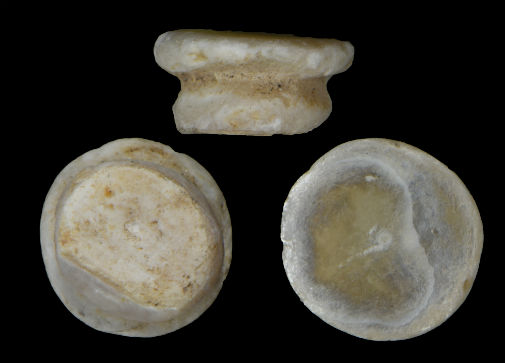Research reveals freshwater mussel shells were material of choice for prehistoric craftsmen
Posted on 7 May 2019

Prehistoric shell ornaments made with freshwater mother-of-pearl. Image credit: Jérôme Thomas (University of Burgundy-Franche-Comté).
An international team of researchers, including academics from the University of York, extracted ancient proteins from prehistoric shell ornaments - which look remarkably similar despite being found at distant locations in Denmark, Romania and Germany - and discovered they were all made using the mother-of-pearl of freshwater mussels.
The ornaments were made between 4200 and 3800 BC and were even found in areas on the coast where plenty of other shells would have been available.
Archaeological evidence suggests the ornaments, known as “double-buttons”, may have been pressed into leather to decorate armbands or belts.
Cross-cultural tradition
Senior author of the study, Dr Beatrice Demarchi, from the Department of Archaeology at the University of York and the University of Turin (Italy), said: “We were surprised to discover that the ornaments were all made from freshwater mussels because it implies that this material was highly regarded by prehistoric craftsmen, wherever they were in Europe and whatever cultural group they belonged to. Our study suggests the existence of a European-wide cross-cultural tradition for the manufacture of these double-buttons”.
Freshwater molluscs have often been overlooked as a source of raw material in prehistory (despite the strength and resilience of mother-of-pearl) because many archaeologists believed that their local origin made them less “prestigious” than exotic marine shells.
Co-author of the paper, Dr André Colonese, from the Department of Archaeology at the University of York, said: “The ornaments are associated with the Late Mesolithic, Late Neolithic and Copper Age cultures. Some of these groups were still living as hunter gatherers, but in the south they were farmers with switching to a more settled lifestyle.
“The fact that these ornaments look consistently similar and are made from the same material suggests there may have been some kind of interaction between these distinct groups of people at this time.
“They may have had a shared knowledge or tradition for how to manufacture these ornaments and clearly had a sophisticated understanding of the natural environment and which resources to use.”
Evolution
Mollusc shells contain a very small proportion of proteins compared to other bio-mineralised tissues, such as bone, making them difficult to analyse.
The researchers are now working on extracting proteins from fossilised molluscs, a method which they have dubbed “palaeoshellomics”. These new techniques could offer fresh insights into some of the earliest forms of life on earth, enhancing our knowledge of evolution.
Dr Demarchi added: “This is the first time researchers have been able to retrieve ancient protein sequences from prehistoric shell ornaments in order to identify the type of mollusc they are made from.
“This research is an important step towards understanding how molluscs and other invertebrates evolved. We hope that using these techniques we will eventually be able to track an evolutionary process which began at least 550 million years ago.”
Explore more news

New butterfly species created 200,000 years ago by two species interbreeding
Thursday 18 April 2024

Children in the North at greater risk of entering care
Wednesday 17 April 2024

Boreal forest and tundra regions worst hit over next 500 years of climate change, study shows
Monday 8 April 2024

Researchers developing ultra-sensitive blood test with potential to revolutionise diagnosis of Alzheimer’s
Thursday 4 April 2024

Attitudes to being an adult are shifting as traditional milestones become out of reach, new study finds
Wednesday 27 March 2024
Media enquiries
About this research
“Palaeoshellomics” reveals the use of freshwater mother-of-pearl in prehistory is published in the journal eLife.
This research was carried out in collaboration with Dr Kirsty Penkman (Department of Chemistry) and Julie Wilson (Department of Mathematics) at the University of York, alongside researchers at the University of Turin and Ca’ Foscari University (Italy), Universities of Burgundy-Franche-Comté and Lille (France), the University of Bradford (UK), the Moesgaard Museum (Denmark), the Landesamt für Denkmalpflege im Regierungspräsidium Stuttgart and the Niedersächsisches Landesamt für Denkmalpflege (Germany).
Explore our research.
